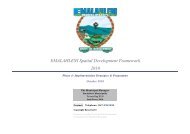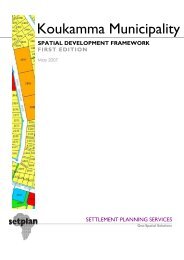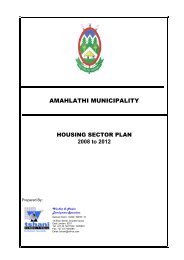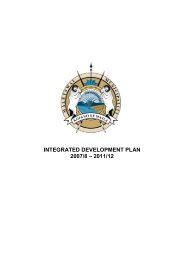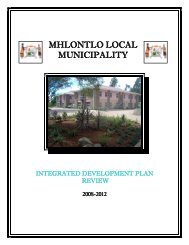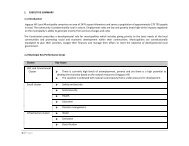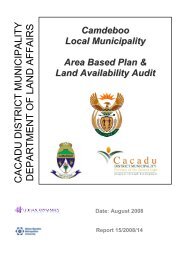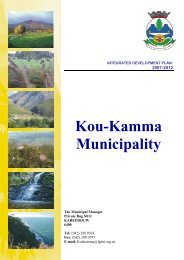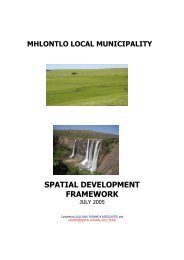intsika yethu local municipality - Provincial Spatial Development plan
intsika yethu local municipality - Provincial Spatial Development plan
intsika yethu local municipality - Provincial Spatial Development plan
You also want an ePaper? Increase the reach of your titles
YUMPU automatically turns print PDFs into web optimized ePapers that Google loves.
The above table indicates the existing infrastructure backlogs within IYLM and considers a backlog to beany infrastructure needs that were there before 1994.Municipal service delivery on these issues is challenged by the low revenue base of the <strong>municipality</strong> fromwhich it finances the provision of these services. At this time, approximately 20% of IYLM’s own revenueis used to fund capital projects and infrastructure developments, with the remainder financed bygovernment grants. However, given the backlogs detailed above, IYLM will need to expand its revenuebase while increasing and effectively applying all government grants if it seeks to make a serious indentinto the extensive backlogs it faces over the new term. At this time, the <strong>municipality</strong> does not have anyother sources of infrastructure investment but the potential to pursue the possibility of public/privatepartnerships remains.Table 22: Funding sources for addressing service delivery backlogSOURCE OFFUNDING2009/2010 2010/2011 2011/2012 TOTALAVAILABLEFUNDINGREQUIREDSHORTFALL/SurplusMIG R 18,586,171 R21,563,804DWAF RR26,000,000 27,000,000MUNICIPAL RR10,400,000 12,000,000TOTAL RR54,986,000 60,564,000R25,934,894R28,000,000R15,000,000R68,935,000R 66,085,000R 81,000,000R 37,400,000R184,485,000R1,471,751,360R1,471,751,360R1,405,666,360-R1,287,266,360Electricity: IYLM receives the supply of electricity through Eskom; the major towns of Cofimvaba andTsomo are served with electricity. The High Voltage (HV) Electrical Power line extends fromKomani/Qamata 1132KV to Qolweni/Manzana 166KV. Another power line extends from Cala/Elliot 166kvto Butterworth/Noora 166kv. About 66% households have access to electricity. According to RSS (2006)surveys the electricity backlog amounted to 44% of total demand, which has subsequently declined. The<strong>municipality</strong> is challenged in this area in that it is not the authority, nor the provider, and therefore itremains reliant on Eskom for the provision of electricity rollout to villages. This is further challenged by afunding shortage to address the existing backlogs.Housing: In terms of IYLM Housing Sector Plan (2008-2012) the area has municipal commonage landwhich is available for future housing developments. The sites are well located in relation to workopportunities and social services. IYLM is currently in the process of drafting a new Housing Sector Planwhich will provide a more updated and comprehensive outline of the trajectory of the <strong>municipality</strong> in thisregard. In particular, informal settlements were previously omitted from the Housing Sector Plan, but arenow being duly considered along with the migratory patterns of the municipal area which has seen atworst, a considerable out-migration of young people, and at best, a stasis in population growth. AMigration Plan is also proposed for consideration as part of Annexure A to this document.One of the bigger challenges in this regard is in the implementation of housing provision which IYLM doesnot have the power to do. Municipal capacity is said to be sufficient to support the provision andexpansion of most bulk services in this regard, but the onus for actual implementation of housingprovision rests with the <strong>Provincial</strong> Department of Human Settlements. For example, the <strong>municipality</strong>currently has <strong>plan</strong>s for approximately 1500 households submitted to the provincial department (608 inJoe Slovo, 283 in Tsomo, 400+ in Cofimvaba, etc). It has made financial provision for the roll-out andextension of bulk services to these areas but remains reliant on approval from the <strong>Provincial</strong> Departmentin order to proceed.Land reform: The existence of communal and informal land ownership systems in some rural areas is amajor challenge to development because it locks land which is needed for improving the lives of ruralpeople. There is a commitment by the Department of Land Affairs to transform land tenure so that ruralhouseholds living on traditional or communal lands can have access to land ownership.59




